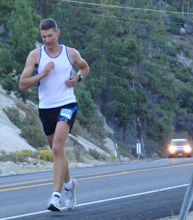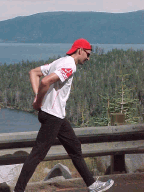 This weekend's Jenkinson Lake Fall Trail Runs 50K was the season finale of the ultrarunner.net grand prix series. The series kicked off with the Pony Express race at the end of February and consisted of 9 races with distances ranging from 20-miles to 12-hour runs.
This weekend's Jenkinson Lake Fall Trail Runs 50K was the season finale of the ultrarunner.net grand prix series. The series kicked off with the Pony Express race at the end of February and consisted of 9 races with distances ranging from 20-miles to 12-hour runs.I am very happy to report that I clinched the series title for the second time!
In 2007, I learned a few lessons about what it takes to win a grand prix series. That year, the series became a mano-y-mano duel with my good friend Scott Dunlap, and I ended up winning the series--and the associated $3000 supersonic mattress grand prize--by just one and a half points (out of 282 total points). In the end it all came down to the last race--if the overall 50-mile winner had run just a few minutes slower, I would taken second place. Way too close!

Jethro Smith Wins Second Place Overall in the Grand Prix
Some people have asked, so at the risk of shooting myself in the foot for a future grand prix series title attempt in 2011 (I am not running the entire series next year), I'll share with you my seven secrets for winning a grand prix running series. Actually, most of these concepts are so basic that they can hardly be called "secrets," but make a few mistakes and your series title hopes can be toast. There is some strategy behind it.
Having run quite a few of these series, I know now that it is actually possible for a non-elite runner (like me) to do quite well or even win. You don't have to be a mountain goat or even super fast. A firm aim coupled with some smart strategy and some hard work (and a little luck) is all you really need. It is true--the tortoise can beat the hair.
- Go For It!--That is, make the conscious decision to compete in the entire series up front, train for it, and add the races to your schedule. Entering one of the early races with a let's-just-see-what-happens attitude leaves a lot to chance.
- Start Out "Guns Blazing"--Once you have decided to really go for it, you want to create the biggest gap on the competition as you can in the shortest amount of time. You want to kick butt and take names starting at race number 1. This doesn't mean that you should show up at the first race and start running like a 10-year old, however. It does mean that you ramp up training well in advance of the first race and taper properly. The first series race is often early in the year and many people will skip running in the cold winter months; instead using the early races to get in shape. It certainly helps if you can be in great shape at the start of the very first race.
- Show Up--This, you could argue, is one of my specialties. As I mentioned before, you don't have to be the fastest runner or the best climber. If you're not at the starting line at 7 a.m. all those great strengths won't do you much good.
- Finish--David Goggins recently said: "It's not about winning; it's about not quitting." That's true. You really don't have to win every race outright to do well, but you have to actually cross the finish line at some point for your results to count towards your overall points.
- Every Minute Counts--While you're in a series race, keep moving forward. In the end, the series could be decided by just a few minutes, so you don't want to think back with regret about that time where you leisurely sat down at an aid station, chatting it up with your friends. For an hour. Also, if you really want to do well, organize a crew that can keep you moving. You can save a huge amount of time with a seasoned crew that is aware of all your preferences. (A huge thank you to Chris, Rebecca, and Troy for coming out to crew for me this year!)
- Read--Carefully read the series rules, and the individual race details, including course maps for races that you have not run before and scout out the race course before the race if you can. Your best race time is usually achieved when you run the most even pace throughout the race. Knowing the course will allow you to set specific time goals for a course.
- Super-Size It--Sometimes races offer a variety of distances. For example, a 6 or a 12-hour run, offering a series point per mile. Always run the absolute longest distance you can to pick up the most points possible. You never know. Sometimes things come up and you may have to miss one of the races (I missed one due to a nearby forest fire this year). Running the longest possible distance every time you can will put some points in the grand prix bank. Occasionally, however, it may pay off to run a shorter distance for some reason. Again, being familiar with the race details is key here.
Yesterday's Race--The Season Finale
Here's a quick report about yesterday's Jenkinson Lake Trail Run 50K.
The race offers a choice of up to four 8-mile, 95% single-track trail loops around Jenkinson Lake. It uses the same course as the Jenkinson Lake Spring Run, except that it was run in reverse and had an extra half mile.
There were some new faces at the start along with some die-hard grand prix racers trying to get some final points in the final race of the season--Gretchen, Lainie, Jethro, and Matt. The race started out fast, I led for the first 4 miles or so and then let the 16-milers set the pace. I chatted briefly with Swedish adventure racer Mats Jensen (last name?) who was running the 24-miler and then it became pretty quiet.
I cranked up some tunes on lap 2 and 3 and was in first place in the 50K, but slowing down a little bit each lap and walking more of the steep hills. The last month of less than 10 training miles and eating danishes was rapidly catching up to me. I plodded my way through the third lap and then, finally, it was time for the victory lap that I had been envisioning since the beginning of the year! The ultra series title was mine unless I fell into Lake Jenkinson and drowned.
Ed Walsh and a friend of his were manning the first aid station and Ed kindly kept me posted on where I was relative to the other 50K runners. A lot of runners dropped down to the 24-mile race and apart from Lainie, who was about five minutes behind me, there was nobody in sight. With the series win in the bag, it was hard to get motivated to pick up the pace significantly.
Lainie, who was running another strong race, passed me at the final aid station of the bell lap--both of us were happy to be done with the race and the series in general. Lainie went on to win the 50K and she also won the female grand prix title, followed by Gretchen and Jennifer Dicus.
I just kept running at my own pace until I reached the finish line, where Lainie, Jethro, and their parents, Matt, Robert, and Linda were all cheering. It was great to finish what I had started so long ago. A huge congratulations to all the other grand prix finishers and their support crews. Next year has even more races, including a new race at Bullard's Bar Dam that I will be designing the course for. Stay tuned for more details on that.
We had a short awards ceremony and the top-three winners overall, as well as the age group winners, received a truckload of goodies and prizes. For winning the series overall, I received an all-expense-paid vacation package worth $550 (the real reason my family was so supportive of these monthly races!) and another $200+ worth of useful other running-related goodies, like two pairs of Inov-8 shoes, Hammer gel, a Fuel Belt hydration pack, and more.
 Jethro (2nd overall), Matt (3rd overall and only one to run every race), and Yours Truly--Watch Out For These Guys Next Year!
Jethro (2nd overall), Matt (3rd overall and only one to run every race), and Yours Truly--Watch Out For These Guys Next Year!Thanks to Robert and Linda, Ed Walsh, and all the other great volunteers, and to the grand prix sponsors for making this an exciting (and rewarding) series. I'll take a break next year, but I may be back for the hat-trick in 2011! So far, in the series history (since 2004), only Beverly Anderson Abbs and I have won two series titles.
Next up: Relaxing... and a few interesting bike rides around Lake Tahoe and around the Sutter Buttes.



















